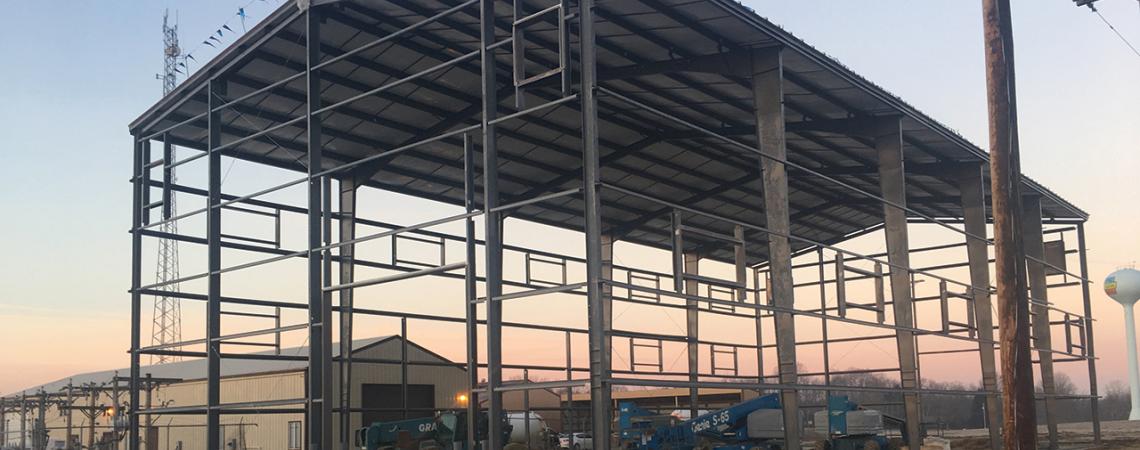The Central Ohio Lineworker Training program’s new building takes shape in advance of enclosing the structure. The finished building was scheduled to open this month.
Being a lineworker is not a particularly easy job; besides the strenuous nature of the work that both keeps the lights on and restores power when there’s an outage, the folks on the poles need to have a knowledge base that ranges from basic knot-tying to electrical engineering.
Not surprisingly, there’s a lot of training that goes into becoming (and remaining) a lineworker. Also not surprisingly, Ohio’s electric cooperatives are leaders in the field of lineworker training.
Those efforts will get a further boost this month, with the opening of the Central Ohio Lineworker Training (COLT) program’s indoor training facility. The new building was constructed at the same Mount Gilead site where co-op line personnel have, for more than a decade, honed their physical and intellectual skills on a 16-acre outdoor training field.
The 7,200-square-foot COLT indoor facility took eight months to build, and includes two classrooms and 10 work stations, where trainees get a hands-on learning experience. The indoor facility has 19 wooden utility poles that are 30-35 feet high, where apprentice lineworkers can practice their climbing and rescue techniques and learn specifics of the transformers and voltage regulators on those poles. It also includes an area where students can learn underground construction and how to maintain an energized underground system.
It takes years to learn the trade
Lineworker training is a rigorous combination of classroom and field work. Candidates take 12 weeks of training over a four-year period. Between training sessions, apprentice lineworkers work at their electric co-op, applying their new skills working alongside experienced journey-level lineworkers.
Chris Napier was in the first COLT graduating class in 2007. “The instruction I received at COLT, combined with my on-the-job experience, helped me grow as a lineman and a leader,” says Napier, who now provides safety training for Ohio’s Electric Cooperatives. “I feel the skills I learned and the strong emphasis on performing the work safely allowed me to serve our members in the best way possible.”
The COLT program has trained and graduated more than 120 lineworkers. Currently, there are 68 students enrolled in the apprentice training program.
Indoor facility expands learning opportunities
Before the facility’s opening, Ohio’s widely varying weather limited hands-on outdoor training to about eight months a year. Now, it can go year-round. “Inclement weather really cut into the effectiveness of training,” says Dwight Miller, director of safety and loss control for Ohio’s Electric Cooperatives. “We only have these guys in training for short periods of time, and it’s important that every hour is maximized.”
Taking weather out of the equation also maximizes learning, according to COLT instructor Kyle Hoffman. “You can work outdoors when it’s 10 degrees, or when it’s raining, but getting students to focus on learning, rather than being in the elements, can be tough,” he says.
Experienced linemen need to ‘sharpen their saws’ too
Experienced linemen can hone their skills in COLT’s newly established Journeyman Refresher Program. While the basics of line work have remained relatively unchanged through the years, there have been many advancements in how the work is performed. These ever-changing aspects of line work require a continuous learning environment for everyone responsible for keeping the lights on.
Most of that learning, along with the technical how-to aspects, involves safety. Safety is not a question of adding another requirement to a job — it’s an integral part of every job, Miller says.
“Working safely comes down to knowing what you can do, and what you can’t. As an electrical lineworker, you have very little room for error.”
Hoffman, who spent 10 years climbing poles as a lineman for Pioneer Electric Cooperative, takes that even further: “We tell our students, ‘If you’re going to make a mistake, make it here at COLT, where you will have the opportunity to learn from it. Out in the field, you may not get a second chance.’”
John Egan is president of Egan Energy Communications, a national energy communications firm.









